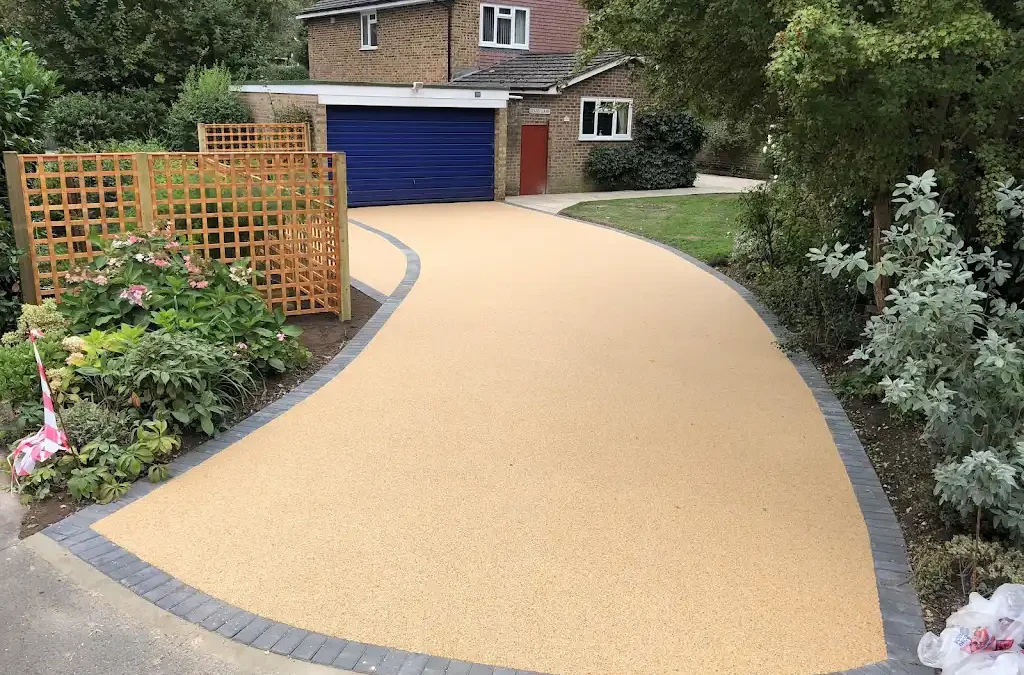What SUDS actually means
Sustainable Urban Drainage Systems are about managing rainwater at source. Instead of rushing water into the road or a combined sewer, SUDS aims to:
- Slow and store rainfall during heavy downpours
- Infiltrate water back into the ground where possible
- Filter and clean runoff before it reaches drains or waterways
- Reduce flood risk and surface water on your property
Why resin-bound fits
Resin-bound paving is porous. Stone and clear resin are mixed, then trowelled to leave tiny, connected voids. Water passes through the surface into a designed base below. That’s the key difference from resin-bonded (which is not fully permeable).
Simply put: resin-bound + the right base = SUDS-friendly.
Our typical SUDS build-ups (what’s under the surface)
Every home is different, but most Surrey properties suit one of these approaches:
1. Infiltration system (best where ground soaks well)
- Resin-bound wearing course
- Open-graded asphalt or binder layer that remains permeable
- MOT Type 3 or similar open, clean stone sub-base (voided storage)
- Separation/geotextile as needed
- Natural soil subgrade for infiltration
2. Attenuation + controlled discharge (clay/heavy soils)
- Same permeable layers above
- Storage layer sized to hold a design storm
- Outlet to a soakaway, rain garden or approved drain with a restrictor
3. Hybrid (steep drives or tricky thresholds)
- Permeable field of resin-bound
- Hidden channels or slot drains only where necessary (e.g. at garage/threshold)
- Storage/discharge designed as above
Surrey realities we design for
- Clay and trees: Much of Epsom & Surrey sits on clay. Infiltration can be slow and roots can move the ground. We size the base for storage and use edging to lock margins.
- Slopes: Drives falling toward a house need a plan. We’ll combine permeability with discreet channels at the threshold, so water goes into the system – not your garage.
- Leaf fall and shade: Keep pores open with simple sweeping. Easy maintenance keeps performance high.
Common mistakes (and how we avoid them)
Confusing resin systems: Resin-bonded scatters stone onto resin; it’s decorative but not fully permeable. We specify resin-bound for SUDS.
- The wrong sub-base: Dense, dusty hardcore blocks pores. We use clean, open-graded stone and keep fines out.
- Over-compaction: We compact correctly without crushing the voids that carry water.
- Blocking the surface: No kiln-dried sand on top. No sealers that choke pores.
- Ignoring levels: Permeable doesn’t mean “flat.” Falls still matter to guide water into the system.
Planning and permissions (the quick version)
Front gardens usually don’t need planning if the surface is permeable and water drains to a permeable area within the boundary. Conservation areas or non-permeable designs are different—ask us. We’ll keep it compliant and straightforward.
Performance you can feel day-to-day
- No more puddles on the surface when it’s raining
- Grip underfoot thanks to a textured, low-glare finish
- Cleaner thresholds—less runoff to the pavement or road
- Low maintenance—sweep leaves; occasional light jet wash
How we specify your resin-bound project
- Site survey: We check soil, slopes, existing base, access and thresholds.
- Hydrology in plain English: Infiltration test if needed; if not, we size a storage layer and outlet.
- Edge details: Blocks, granite sets or aluminium restraints to hold lines and protect margins.
- Build-up and thickness: We choose the system, stone size and depth for your traffic loads.
- Finishing & care: Clear return-to-use times and a simple aftercare sheet.
Resin-bound vs the alternatives (SUDS lens on)
- Resin-bound: Permeable, clean look, minimal upkeep; pairs with a designed base for flood resilience.
- Block paving: Can be SUDS-friendly if you use permeable blocks and a permeable base; joints need periodic care.
- Tarmac/concrete: Non-permeable. Needs channels, soakaways or tanks to meet SUDS aims.
Maintenance that keeps it permeable
- Sweep leaves and grit before they break down into fines
- Low-pressure wash with a fan lance; keep the nozzle moving
- Treat algae in shaded areas with resin-safe cleaner if needed
- No sealers that fill the pores; no harsh solvents or bleach
Will resin-bound handle heavy rain?
I’m on clay - can it still be permeable?
What if my drive slopes toward the house?
Do I need planning?
Why choose LA Surfacing
- Family-run, local team focused on quality – not quantity
- One project per team at a time, done properly
- Clear advice on SUDS, drainage and build-ups – no jargon
- Samples, borders and blends to suit your home
- Workmanship guarantees and product warranties for peace of mind
Next steps
Book a quick site visit. We’ll check levels and ground conditions, show you blends and edging, and design a resin-bound, SUDS-friendly build-up that fits your home. Clear scope. Fixed quotation. No surprises.




Recent Comments